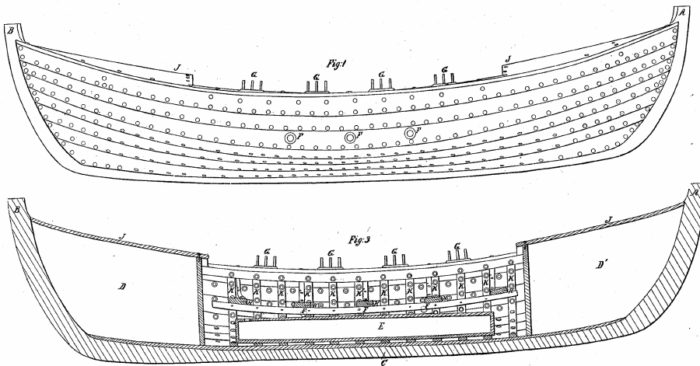 As always, I am on the lookout for inventions that were either made or tested at the Washington Navy Yard.
As always, I am on the lookout for inventions that were either made or tested at the Washington Navy Yard.
On March 2, 1858, a brief item appeared in the Washington Evening Star, stating that a “trial of Holmes’s ‘Self-righting Turf and Life Boat’ was to take place at the Navy Yard this morning.” The Star did not elaborate any further, and thus it fell to the Washington Union to explain this somewhat cryptic statement further. Sadly, nobody from the Union was there to observe the trial, but they still said that those “that witnessed the trial speak in the highest terms of its merits as a life-boat, there being little in its righting or self-bailing qualities that can get out of order, while it has great buoyant properties.”
It takes a look at the patent filed by one Richard Collins Holmes the previous year to get more information on this new invention.
Holmes was a resident of Cape May, New Jersey, and he had inherited a house from his father on land his grandfather had bought in 1776. While Richard Holmes only had about six acres, he used tidal mud as a fertilizer to get the most of the land. He was also an insurance agent, judge and a collector of customs. Additionally, he was interested in life-saving, and in 1849 had helped rescue some 400 passengers and crew from the Eudora, a ship sailing from New York to California. In rescuing them and their baggage, he used a Metallic Surf Boat as invented by Joseph Francis in 1845. He wrote glowingly of its service, that his men had said that “it was only fun to play in the breakers with her.”

Detail of the patent drawing from Holmes’s invention. The buoyancy tanks can be seen left and right on the bottom drawing. (Google Patents)
Holmes had thereafter busied himself with improving Francis’s design, and had come up with a method for making the boat not only sturdy and easy to maneuver, but also ensure that it could not sink. The main invention here were to buoyant tanks fore and aft in the boat, which ensured that no amount of water taken aboard could cause it to go under. The location and size of these tanks also would “when the boat is bottom upward, … place the center of gravity in an unstable position so that it is free to descend, and in doing so must ‘right’ the boat.” In other words, a self-righting ship.
The success of the trial at the Navy Yard was such that a bill was introduced in the House of Representatives indicating that enough of the Holmes boats should be bought to outfit all 28 life-saving stations in New Jersey. Unfortunately, when the Senate got ahold of the bill, they changed the word “Holmes’s” to “the best.” Even more surprisingly, this change was done by Senator John Renshaw Thomson (pictured) from New Jersey. Which boats this ended up being is unclear: Certainly the Holmes boats are not as well-known as Francis’s metal boats.
Today, Richard Holmes is best known for his farm, which was turned into a museum on Cape May.
